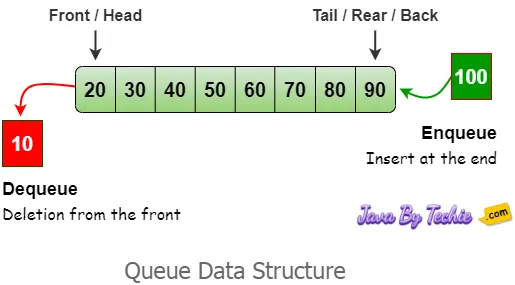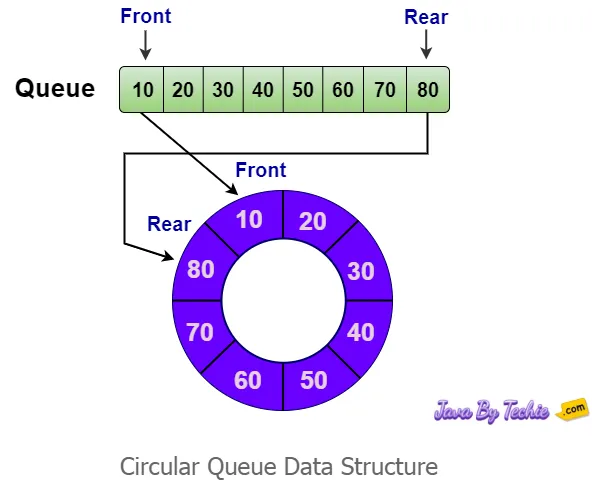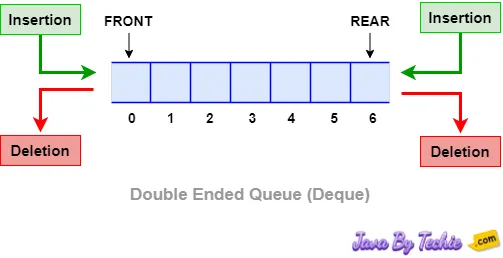

Last Updated: 06 October, 2024 6 Mins Read
A Queue is a fundamental data structure used to store and manage elements (data) in a sequencial order. Queue is commonly used in various applications, such as job scheduling, printer task management, Task Scheduling, batch processsing and many more.
In this tutorial, we will explore all about the Queue data structure, it's operations, types, implementation etc. in details.
A Queue is a linear data structure to store and manipulate the data elements. The queue data structure apply the concept of "First in, First out" (FIFO), which means the first added element into the queue to be the first removed from the queue. Queues do not allow random insertion and deletion operations.
A Queue is open at both ends, which enables insert operations to be performed at one end called REAR or TAIL and delete operations to be performed at another end called FRONT or HEAD.

We can understand the concept of queue using the real-world example, A queue is the line outside a movie theater where the first person to enter gets the ticket first and the last person to enter gets the ticket last. A similar strategy is used in the data structure's queue.

Queues are easy to use and effective managing data flow, they are frequently used in a wide range of algorithms and applications.
Enqueue: Add a new element to the end of the queue.
Dequeue: Remove an element from the front of the queue.
Peek or front: Retrieve the frontmost element in the queue without deleting it.
rear: Returns the element at the end in the queue without deleting it.
isFull: Checks if the queue is full.
| Operations | Time Complexity | Space Complexity |
|---|---|---|
| enqueue | O(1) | O(1) |
| dequeue | O(1) | O(1) |
front | O(1) | O(1) |
| size | O(1) | O(1) |
| isEmpty | O(1) | O(1) |
isFull | O(1) | O(1) |
Queues can be implemented in two ways:
There are the four different types of queue that are given below:
A Simple Queue or Linear Queue is a linear data structure to store and manipulate the data elements. The queue data structure apply the concept of "First in, First out" (FIFO), which means the first added element into the queue to be the first removed from the queue. Queues do not allow random insertion and deletion operations.
A Circular Queue is another type of queue; it also follows the principle of First in, First out" (FIFO). In the circular queue, the last element is connected to the first element of the queue, forming a circle.
A circular queue allows us to keep on inserting an element; if it reaches the end of the queue, then again insert from the start. Such types of queues are very efficient and useful for tasks like buffering data in a computer system, managing waiting lists, and making sure no memory space is wasted.
Circular queue is also called Ring Buffer.
Circular Queue Representation

A priority queue is one particular kind of queue where each element of a queue is associated with a priority value, and elements are processed according to their priority, which means higher-priority elements are processed first.
Characteristics of a Priority queue:
The Deque stands for "Double Ended Queue".
Deque is an another type of queue which allows elements to be added or removed from both the front and the back which means we can insert and delete an element at the front end or rear end both.
Deque provides greater flexibility than a standard queue. This makes it particularly useful for scenarios where we need to access elements from both ends efficiently.
The following diagram represents a Deque in data structure.

That's all, guys. I hope this article is helpful for you.
Happy Learning... 😀
feedback@javabytechie.com